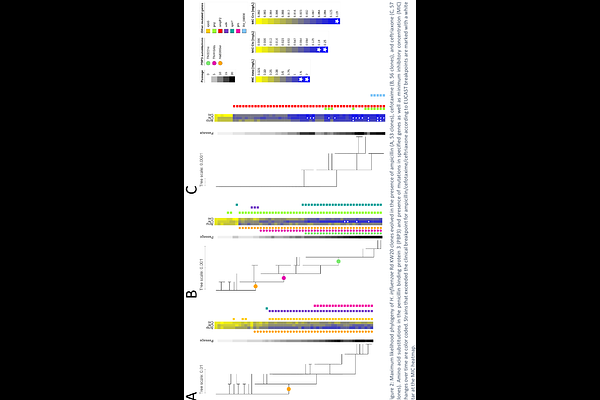Evolution of β-lactam resistance causes fitness reductions and several cases of collateral sensitivities in the human pathogen Haemophilus influenzae

Evolution of β-lactam resistance causes fitness reductions and several cases of collateral sensitivities in the human pathogen Haemophilus influenzae
Petersen, S.; Diricks, M.; Utpatel, C.; Schulenburg, H.; Merker, M.
AbstractThe evolution of antimicrobial resistant (AMR) pathogens poses a global health threat and it is unclear if evolutionary trajectories to resistance lead to predictable phenotypes. We analyzed AMR-evolution in the human pathogen Haemophilus influenzae in controlled evolution experiments with increasing concentrations of either ampicillin, cefotaxime, or ceftriaxone. We isolated 315 clones from different time points of six independent experiments and characterized changes in genome sequences, bacterial fitness, and minimum inhibitory concentrations (MICs) to 14 antibiotics. Resistance evolution under ampicillin and cefotaxime was driven by mutations in the ftsI gene, encoding the penicillin-binding protein 3. However, ceftriaxone exposure mainly selected for mutations in the outer membrane protein P2 (OmpP2). Some OmpP2-mutants reproducibly showed heteroresistance for ceftriaxone but also for fluoroquinolones, rifampicin and tetracycline. Bacterial fitness assessments revealed trade-offs between resistance-associated mutations and growth, though no systematic correlation of MIC increase and growth deficit was detected. Over 50% of the mutants became more susceptible to aminoglycosides, clarithromycin, and colistin, while some mutation patterns resulted in cross-resistance to meropenem and fluoroquinolones. Overall, beta-lactam antibiotics reproducibly selected mutants with increased MICs, but evolutionary pathways and resulting phenotypes remain unpredictable, challenging current AMR treatment guidelines, and recommendations for last resort antibiotics.